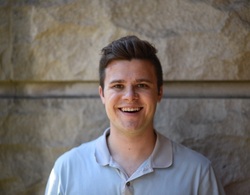10/17/2024 Brock Carlson: Preattentive V1 Representations Resolve Interocular Conflict with Laminar Coherence
CCN Brown Bag

Brock Carlson
Graduate Student, Maier Lab
Date: Thursday, October 17, 2024
Time: 12:10PM-1PM
Location: 316 Wilson Hall
Preattentive V1 Representations Resolve Interocular Conflict with Laminar Coherence
Psychophysical studies show that attention is necessary for standard dynamics in binocular rivalry (Brascamp & Blake, 2012; Dieter et al., 2016). When attention is diverted, interocular processing occurs without fusion (Qian et al., 2019), and rivalry-induced traveling waves are observed in V1 but not higher visual areas (Lee et al., 2007). Even under anesthesia, V1 neurons maintain adaptation-dependent activity during binocular rivalry flash suppression (BRFS; Bahmani et al., 2014), suggesting V1’s automatic role in resolving interocular conflict. In line with Feature Integration Theory (Treisman & Gelade, 1980) or Guided Search (Wolfe, 2021), V1 preattentively processes each eye’s view, though neurophysiology shows sustained firing reflects the dichoptic stimulus, not the perceptual outcome (Keliris et al., 2010; Leopold & Logothetis, 1996; Maier et al., 2008). We explored how laminar coherence in V1 resolves this conflict. While spiking activity didn’t guide feature selection, dichoptic stimulation lowered laminar coherence compared to dioptic stimulation, with similar decreases during BRFS suppression. This coherence drop, especially between deep and upper layers, suggests V1 may select eye-based features through neuronal timing, providing bottom-up guidance for visual awareness during rivalry.
Questions? Contact Isabel Gauthier